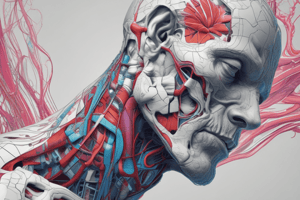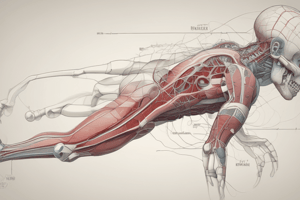Podcast
Questions and Answers
What is the primary function of a tissue in the body?
What is the primary function of a tissue in the body?
- To perform specific functions (correct)
- To provide structural support
- To produce hormones
- To regulate body temperature
Which of the following is a characteristic of epithelial tissue?
Which of the following is a characteristic of epithelial tissue?
- Cells are highly vascularized
- Cells are highly innervated
- Cells are tightly joined together (correct)
- Cells are loosely connected
What is the origin of epithelial tissue?
What is the origin of epithelial tissue?
- From the three germ layers: ectoderm, mesoderm, and endoderm (correct)
- From the ectoderm and mesoderm layers
- From the endoderm layer only
- From the mesoderm layer only
What is the main difference between simple and stratified epithelium?
What is the main difference between simple and stratified epithelium?
What type of epithelium lines the blood vessels?
What type of epithelium lines the blood vessels?
Which type of epithelium is characterized by the presence of goblet cells?
Which type of epithelium is characterized by the presence of goblet cells?
What is the function of epithelial tissue in the respiratory tract?
What is the function of epithelial tissue in the respiratory tract?
What is the characteristic of epithelial tissue that allows it to regenerate?
What is the characteristic of epithelial tissue that allows it to regenerate?
Match the type of epithelium with its characteristic:
Match the type of epithelium with its characteristic:
Match the type of epithelium with its characteristic:
Match the type of epithelium with its characteristic:
Match the type of epithelium with its characteristic:
Match the type of epithelium with its characteristic:
Match the type of epithelium with its characteristic:
Match the type of epithelium with its characteristic:
Match the type of epithelium with its characteristic:
Match the type of epithelium with its characteristic:
Match the type of epithelium with its characteristic:
Match the type of epithelium with its characteristic:
Match the type of epithelium with its characteristic:
Match the type of epithelium with its characteristic:
Match the type of epithelium with its characteristic:
Match the type of epithelium with its characteristic:
Flashcards are hidden until you start studying
Study Notes
Tissues of the Body
- A tissue is a group of cells with similar morphological characteristics, specialized to perform specific functions.
- There are 4 basic tissues in the body: epithelial, connective, muscular, and nervous tissue.
Epithelial Tissue
- Epithelial tissue forms continuous sheets of cells that line internal cavities and cover the external surfaces of the body.
- General characteristics of epithelial tissue:
- Cells are tightly joined together.
- Cell boundaries are ill-defined.
- Cells rest on a basement membrane.
- Originate from the three germ layers: ectoderm, mesoderm, and endoderm.
- Avascular but highly innervated.
- Cells can regenerate.
- Can modify to form other types (glandular epithelium, neuro-epithelium, and myo-epithelium).
Classification of Epithelial Tissue
- Surface Epithelium: covers surfaces of the body or lines luminal cavities within the body.
- Types of epithelial tissue:
- Simple epithelium: one layer of cells.
- Stratified epithelium: more than one layer of cells.
- Squamous epithelium: flat, plate-like cells.
- Squamous keratinized epithelium: found in skin.
- Transitional epithelium: found in urinary tract.
- Glandular epithelium: forms glands.
- Neuro-epithelium: forms sensory receptors.
- Myo-epithelium: found in exocrine glands.
- Columnar epithelium: tall, column-like cells.
- Cuboidal epithelium: cube-like cells.
- Pseudo-stratified columnar epithelium: appears multi-layered but is not.
- Ciliated epithelium: has hair-like structures.
- Pseudo-stratified columnar epithelium with goblet cells: found in respiratory tract.
- Respiratory epithelium: lines the upper respiratory tract (nasal cavity, trachea, and bronchi).
- Simple squamous epithelium: lines blood vessels.
- Simple columnar epithelium: lines the digestive tract.
- Simple cuboidal epithelium: lines the kidneys and adrenal glands.
- Pseudostratified columnar epithelium: lines the respiratory tract.
Tissues of the Body
- A tissue is a group of cells with similar morphological characteristics, specialized to perform specific functions.
- There are 4 basic tissues in the body: epithelial, connective, muscular, and nervous tissue.
Epithelial Tissue
- Epithelial tissue forms continuous sheets of cells that line internal cavities and cover the external surfaces of the body.
- General characteristics of epithelial tissue:
- Cells are tightly joined together.
- Cell boundaries are ill-defined.
- Cells rest on a basement membrane.
- Originate from the three germ layers: ectoderm, mesoderm, and endoderm.
- Avascular but highly innervated.
- Cells can regenerate.
- Can modify to form other types (glandular epithelium, neuro-epithelium, and myo-epithelium).
Classification of Epithelial Tissue
- Surface Epithelium: covers surfaces of the body or lines luminal cavities within the body.
- Types of epithelial tissue:
- Simple epithelium: one layer of cells.
- Stratified epithelium: more than one layer of cells.
- Squamous epithelium: flat, plate-like cells.
- Squamous keratinized epithelium: found in skin.
- Transitional epithelium: found in urinary tract.
- Glandular epithelium: forms glands.
- Neuro-epithelium: forms sensory receptors.
- Myo-epithelium: found in exocrine glands.
- Columnar epithelium: tall, column-like cells.
- Cuboidal epithelium: cube-like cells.
- Pseudo-stratified columnar epithelium: appears multi-layered but is not.
- Ciliated epithelium: has hair-like structures.
- Pseudo-stratified columnar epithelium with goblet cells: found in respiratory tract.
- Respiratory epithelium: lines the upper respiratory tract (nasal cavity, trachea, and bronchi).
- Simple squamous epithelium: lines blood vessels.
- Simple columnar epithelium: lines the digestive tract.
- Simple cuboidal epithelium: lines the kidneys and adrenal glands.
- Pseudostratified columnar epithelium: lines the respiratory tract.
Studying That Suits You
Use AI to generate personalized quizzes and flashcards to suit your learning preferences.




